Virtual administrative tasks encompass a wide range of responsibilities that can be performed remotely, leveraging technology to facilitate communication and collaboration. These tasks are typically designed to support the operational needs of a business, allowing organizations to maintain efficiency without the necessity of a physical office presence. The rise of remote work has made virtual administrative roles increasingly popular, as they provide flexibility and scalability for businesses of all sizes.
Virtual assistants (VAs) can handle everything from scheduling appointments and managing emails to conducting research and maintaining databases, all while working from their own locations. The concept of virtual administrative tasks is rooted in the idea of outsourcing non-core functions to free up time for business owners and employees to focus on strategic initiatives. This shift has been accelerated by advancements in technology, which have made it easier than ever to communicate and collaborate across distances.
As businesses continue to adapt to a more digital landscape, understanding the nuances of virtual administrative tasks becomes essential for maximizing productivity and ensuring that operations run smoothly.
Key Takeaways
- Virtual administrative tasks refer to the delegation of administrative duties to a remote assistant, often using digital tools and technology.
- Businesses can benefit from virtual administrative tasks by saving time and money, increasing efficiency, and gaining access to a wider talent pool.
- Common types of virtual administrative tasks include email management, scheduling, data entry, and customer support.
- Delegating virtual administrative tasks involves clear communication, setting expectations, and providing necessary training and resources.
- When choosing a virtual administrative assistant, consider their skills, experience, communication style, and availability to ensure a good fit for your business.
Benefits of Virtual Administrative Tasks for Businesses
Flexibility and Cost Savings
Virtual assistants often work on a freelance or contract basis, allowing companies to pay only for the hours worked or specific tasks completed. This flexibility can lead to substantial savings, particularly for small businesses or startups that may have limited budgets.
Access to a Global Talent Pool
Another advantage of virtual administrative tasks is the ability to access a global talent pool. Businesses are no longer restricted to hiring local talent; they can find skilled virtual assistants from around the world who possess the specific expertise needed for their operations.
Enhanced Skill Set and Innovation
This diversity not only enhances the skill set available to a business but also brings different perspectives and ideas that can drive innovation. Furthermore, virtual assistants often have experience working with various industries, which can provide valuable insights into best practices and efficient workflows.
Types of Virtual Administrative Tasks

Virtual administrative tasks can be categorized into several distinct areas, each serving a unique purpose within an organization. One common category is communication management, which includes tasks such as managing emails, scheduling meetings, and handling customer inquiries. Effective communication is vital for any business, and virtual assistants can help streamline these processes, ensuring that important messages are prioritized and responded to promptly.
Another significant area is data management and organization. This includes tasks like maintaining databases, updating records, and conducting research. Virtual assistants can help ensure that data is accurate and up-to-date, which is crucial for informed decision-making.
Additionally, they can assist with project management by tracking deadlines, coordinating team efforts, and ensuring that projects stay on schedule. By delegating these tasks to virtual assistants, businesses can focus on their core competencies while maintaining an organized and efficient workflow.
How to Delegate Virtual Administrative Tasks
| Task | Metric |
|---|---|
| Email Management | Number of emails processed per day |
| Calendar Management | Number of appointments scheduled and managed |
| Data Entry | Accuracy and speed of data entry |
| Research | Number of research tasks completed |
| Customer Support | Customer satisfaction rating |
Delegating virtual administrative tasks effectively requires clear communication and a well-defined process. The first step is to identify which tasks can be delegated based on their complexity and the skills required to complete them. Business owners should assess their workload and determine which responsibilities consume the most time or are outside their area of expertise.
Once these tasks are identified, they can be documented in detail, outlining specific expectations, deadlines, and desired outcomes. After identifying the tasks to delegate, it’s essential to establish a communication framework with the virtual assistant. This includes setting up regular check-ins to discuss progress, address any challenges, and provide feedback.
Utilizing project management tools can also facilitate this process by allowing both parties to track task completion and share updates in real-time. By fostering an open line of communication and providing clear instructions, businesses can ensure that virtual administrative tasks are executed efficiently and effectively.
Choosing the Right Virtual Administrative Assistant
Selecting the right virtual administrative assistant is crucial for maximizing the benefits of outsourcing these tasks. The first step in this process is to define the specific skills and qualifications required for the role. This may include proficiency in certain software applications, experience in a particular industry, or strong organizational skills.
Creating a detailed job description that outlines these requirements will help attract candidates who are well-suited for the position. Once potential candidates have been identified, conducting thorough interviews is essential. This allows business owners to assess not only the candidates’ technical skills but also their communication style and cultural fit within the organization.
It’s beneficial to ask situational questions that gauge how candidates would handle specific challenges or scenarios related to the tasks they would be responsible for. Additionally, reviewing references and past work experiences can provide valuable insights into a candidate’s reliability and work ethic.
Tools and Technology for Streamlining Virtual Administrative Tasks

The effective management of virtual administrative tasks relies heavily on the use of technology and tools designed to enhance productivity and collaboration. Project management software such as Trello or Asana allows teams to organize tasks visually, assign responsibilities, and track progress in real-time. These platforms facilitate transparency and accountability among team members, ensuring that everyone is aligned on project goals.
Communication tools like Slack or Microsoft Teams are also vital for maintaining seamless interactions between business owners and virtual assistants. These platforms enable instant messaging, video calls, and file sharing, making it easy to collaborate regardless of geographical location. Additionally, cloud-based storage solutions such as Google Drive or Dropbox provide a centralized location for documents and files, allowing both parties to access important information anytime and anywhere.
By leveraging these tools effectively, businesses can streamline their virtual administrative processes and enhance overall productivity.
Best Practices for Managing Virtual Administrative Tasks
To ensure that virtual administrative tasks are managed effectively, businesses should adopt several best practices that promote efficiency and accountability. One key practice is setting clear expectations from the outset. This includes defining roles and responsibilities, establishing deadlines, and outlining performance metrics that will be used to evaluate success.
By providing a structured framework for task completion, businesses can minimize misunderstandings and ensure that everyone is on the same page. Regular feedback is another essential component of effective management. Business owners should schedule periodic check-ins with their virtual assistants to discuss progress, address any challenges encountered, and provide constructive feedback on performance.
This not only helps maintain open lines of communication but also fosters a sense of collaboration and teamwork. Additionally, recognizing achievements—whether big or small—can motivate virtual assistants and reinforce their value within the organization.
Measuring the Success of Virtual Administrative Tasks
Measuring the success of virtual administrative tasks involves evaluating both quantitative and qualitative metrics that reflect performance outcomes. One approach is to track key performance indicators (KPIs) related to task completion rates, turnaround times, and overall productivity levels. For instance, if a virtual assistant is responsible for managing customer inquiries, measuring response times and customer satisfaction ratings can provide valuable insights into their effectiveness.
Qualitative assessments are equally important in gauging success. Gathering feedback from team members about their experiences working with virtual assistants can highlight areas for improvement or identify best practices that contribute to successful collaboration. Additionally, conducting regular reviews of completed tasks against established goals can help determine whether the delegation of responsibilities has led to increased efficiency or allowed business owners to focus more on strategic initiatives.
By employing a comprehensive approach to measuring success, businesses can continuously refine their processes and maximize the benefits of virtual administrative support.






